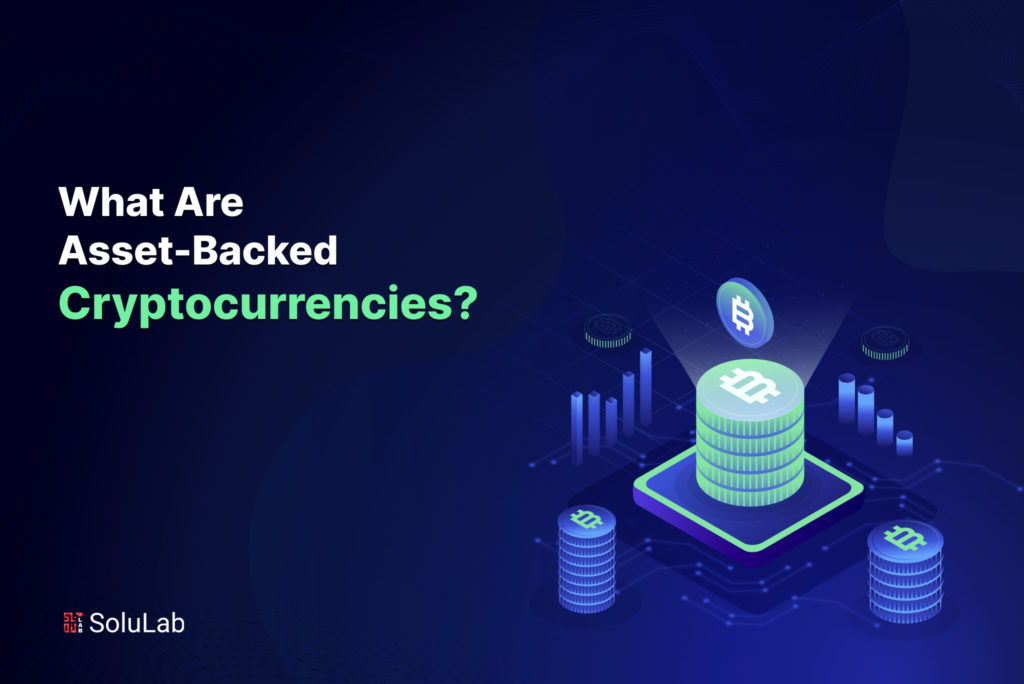
Asset-backed cryptocurrencies combine the solidity of physical assets with the creative potential of blockchain technology, making a substantial advancement in the field of digital currencies. Asset-backed cryptocurrencies are linked to tangible assets like gold, fiat money, or real estate, in contrast to ordinary cryptocurrencies, which are subject to excessive volatility as a result of market speculation. They are a desirable choice for investors looking for portfolio stability because of this relationship which offers protection against price swings.
This blog will cover everything you need to know about what is cryptocurrency backed by and the reasons for why you need it along with the benefits it holds.
What are Asset-Backed Cryptocurrencies?
Cryptocurrencies that are backed by physical assets like fiat money, commodities, or real estate are referred to as asset-backed cryptocurrencies or stablecoins. They are baked by actual assets, cryptocurrencies provide further protection in contrast to conventional cryptocurrencies like Ethereum or Bitcoin whose worth is solely dependent on the market demand and speculation. As a result, they are more stable and less volatile their equivalent that is not supported.
Cryptocurrencies backed by physical assets are not a novel idea. It goes back to the beginnings of cryptocurrencies when engineers were trying to figure out how to create a reliable and stable digital currency. Tether (USDT), the first asset-backed cryptocurrency, was introduced in 214 and immediately became well-linked by traders and investors seeking a more reliable substitute for Bitcoin.
What are the Advantages of Asset-backed Cryptocurrency?

Asset-backed cryptocurrencies (ABCs) have ushered in a paradigm shift in the world of digital finance, presenting a host of distinct advantages that set them apart from traditional cryptocurrencies. As these innovative tokens combine the power of blockchain technology with the backing of tangible assets, they offer a plethora of benefits that resonate with investors and users across the globe. Below, we explore the key advantages that make asset-backed cryptocurrency a compelling proposition for both seasoned financial players and newcomers alike.
-
Stability and Reduced Volatility
One of the most prominent advantages of asset-backed cryptocurrencies is their inherent stability compared to conventional cryptocurrencies. By anchoring their value to tangible assets like precious metals, real estate, or fiat currencies, ABCs mitigate the extreme price fluctuations often associated with purely speculative tokens. This stability inspires confidence among investors and creates an attractive haven for risk-averse individuals seeking a reliable store of value in the digital realm.
-
Transparency and Verifiability
Asset-backed cryptocurrency enhances transparency and verifiability within the financial ecosystem. The underlying assets that back these tokens are held in reserve and can be publicly audited, ensuring that the value of the cryptocurrency is directly tied to the real-world assets it represents. This level of transparency fosters trust and accountability, crucial factors in driving widespread adoption and acceptance of these digital assets.
-
Lower Counterparty Risk
Traditional financial systems involve several intermediaries, adding layers of counterparty risk to transactions. In contrast, asset-backed cryptocurrencies leverage blockchain technology, enabling peer-to-peer transactions with minimized counterparty risk. Smart contracts play a pivotal role in automating processes and ensuring that all parties fulfill their obligations, thereby reducing the potential for default or fraud.
-
Increased Accessibility and Inclusion
Asset-backed cryptocurrency opens up new avenues of financial participation, especially for individuals who face barriers to traditional financial services. With a smartphone and internet access, anyone can access and invest in these digital assets, empowering the unbanked and underbanked populations worldwide. This democratization of finance can lead to greater financial inclusion and economic empowerment for millions.
-
Fractional Ownership and Liquidity
Tokenization of assets enables fractional ownership, breaking down large assets like real estate or artwork into smaller tradable units. This innovation democratizes investments, allowing individuals to own a fraction of high-value assets that were previously beyond their reach. Moreover, it enhances asset liquidity, as these fractional tokens can be easily traded on blockchain-based exchanges, providing investors with more flexible and accessible ways to buy or sell their holdings.
-
Diversification Opportunities
Asset-backed cryptocurrency expands the investment landscape, providing access to a diverse range of asset classes. Investors can now diversify their portfolios with exposure to multiple traditional assets, cryptocurrencies, or commodities, thereby potentially reducing risk and maximizing returns.
-
Global Reach and Efficiency
Blockchain technology underpinning ABCs enables instant, borderless transactions, eliminating the need for intermediaries and reducing transaction fees and processing times. This global reach and efficiency make asset-backed cryptocurrency particularly appealing for cross-border transactions and remittances, facilitating a seamless and cost-effective transfer of value across international borders.
What are the Best Asset-backed cryptocurrencies?

As of my last update in September 2021, the landscape of asset-backed cryptocurrency has likely evolved considerably, with new projects and assets entering the market. Please note that the information provided here might not reflect the most current status of the cryptocurrency market. Therefore, it is essential to conduct thorough research and consult up-to-date sources when considering investments in asset-backed cryptocurrency.
That said, historically, several asset-backed cryptocurrencies have garnered attention for their innovative approach and potential value. Here are some examples of asset-backed cryptocurrencies that were considered prominent:
-
Tether (USDT)
Tether is one of the most well-known examples of a stablecoin backed by fiat currency. Each USDT token is pegged to the value of one US dollar, and the reserves backing the stablecoin are regularly audited to ensure transparency and confidence among users.
-
USD Coin (USDC)
Similar to Tether, USD Coin is a stable coin backed by the US dollar on a one-to-one basis. It has gained popularity due to its compliance with regulatory standards and its use in various decentralized finance (DeFi) applications.
-
PAX Gold (PAXG)
PAX Gold is an asset-backed cryptocurrency that represents ownership of physical gold. Each PAXG token is backed by one troy ounce of a London Good Delivery gold bar, providing investors with exposure to the precious metal in a digital form.
Read Our Blog: Best Crypto Wallets
-
Binance USD (BUSD)
Binance USD is a stablecoin issued by the cryptocurrency exchange Binance. It is backed by the US dollar and has been widely adopted for trading purposes due to its association with a reputable exchange.
-
CryptoFranc (XCHF)
CryptoFranc is a stablecoin pegged to the Swiss Franc (CHF). It operates on the Ethereum blockchain and is audited regularly to ensure the required reserves back the total number of issued tokens.
-
Terra (LUNA)
Terra is a top blockchain platform that issues stablecoins pegged to various fiat currencies, such as the TerraSDR (SDR- Special Drawing Rights), which is a basket of international reserve currencies.
-
Wrapped Bitcoin (WBTC)
Wrapped Bitcoin is an ERC-20 token that represents Bitcoin (BTC) on the Ethereum blockchain. Each WBTC is backed by an equivalent amount of BTC, allowing users to access DeFi applications with their Bitcoin holdings.
-
DigixDAO (DGD)
DigixDAO is a project that aims to tokenize physical gold on the Ethereum blockchain. Each token, such as Digix Gold (DGX), represents a specific weight of gold, allowing users to own and transfer the precious metal digitally.
How is Asset-backed Cryptocurrency Different?

Asset-backed cryptocurrencies (ABCs) represent a revolutionary departure from conventional cryptocurrencies like Bitcoin and Ethereum, fundamentally altering the way we perceive and interact with digital assets. While both ABCs and traditional cryptocurrencies operate on blockchain technology, the key differentiator lies in the intrinsic value and tangible backing that ABCs possess. Let’s explore the distinct characteristics that set asset-backed cryptocurrencies apart from their non-backed counterparts:
-
Underlying Tangible Assets
The most significant difference between ABCs and traditional cryptocurrencies is the presence of underlying tangible assets. Unlike Bitcoin and other purely digital tokens, ABCs derive their value from real-world assets, such as precious metals, fiat currencies, commodities, or even physical properties like real estate. These tangible reserves instill a level of trust and stability in ABCs, as their value is tied directly to the performance of the assets they represent.
-
Price Stability
One of the primary challenges faced by conventional cryptocurrencies is their notorious price volatility. The value of non-backed tokens is subject to wild swings due to market speculation, investor sentiment, and external factors. In contrast, ABCs offer enhanced stability due to their underlying asset reserves. The price fluctuations of ABCs are more closely tied to the performance of the backing assets, resulting in a relatively more stable valuation.
-
Transparency and Audibility
Asset-backed cryptocurrency often provides greater transparency compared to traditional cryptocurrencies. The presence of tangible assets means that these tokens can be audited and verified independently. This transparency fosters trust among users and investors, as they can be assured that the value of their ABC holdings is backed by real, tangible assets.
Read Also: Top 10 Decentralized Crypto Exchanges
-
Risk Mitigation
The presence of underlying assets in ABCs mitigates certain risks associated with traditional cryptocurrencies. While non-backed cryptocurrencies are susceptible to market sentiment and speculative bubbles, ABCs’ value is anchored to tangible assets, providing a level of risk hedging against market downturns.
-
Enhanced Regulatory Compliance
Asset-backed cryptocurrency often finds favor with regulators and authorities due to their intrinsic ties to real-world assets. The backing of tangible reserves offers an added layer of legitimacy and accountability, which can facilitate smoother integration into existing regulatory frameworks.
-
Utility and Use Cases
Asset-backed cryptocurrency can offer unique utility and use cases beyond mere speculation and investment. For instance, certain ABCs may enable streamlined cross-border transactions, and remittances, or facilitate fractional ownership of high-value assets. These use cases enhance the real-world applicability and utility of ABCs, making them more than just speculative instruments.
-
Financial Inclusion
By combining the benefits of blockchain technology with tangible backing, ABCs have the potential to foster financial inclusion. They can provide a gateway for individuals without access to traditional banking services to participate in the global financial ecosystem, opening up opportunities for investment and economic empowerment.
What is the Role of Smart Contracts in Asset-backed Cryptocurrency?
Smart contracts play a pivotal role in asset-backed cryptocurrency, revolutionizing the way traditional assets are tokenized and transferred on the blockchain. These self-executing contracts, written as lines of code, facilitate the seamless exchange of value and ownership, ensuring transparency, security, and automation within the asset-backed crypto ecosystem. The integration of smart contracts has paved the way for the emergence of a new era in finance, where real-world assets and digital tokens can coexist harmoniously.
-
Automated Asset Management
Smart contracts enable the automatic management of asset-backed cryptocurrency. Once the terms and conditions of the contract are coded into the blockchain, the contract will execute itself based on predefined triggers and actions. This automation reduces the need for intermediaries and minimizes human intervention, leading to greater efficiency and cost-effectiveness.
-
Trust and Transparency
The immutability of blockchain technology ensures that smart contracts operate with complete transparency. All contract terms and asset information are recorded on the blockchain, accessible to all participants in real-time. This transparency fosters trust among stakeholders as they can independently verify the details of the contract and the underlying assets.
-
Decentralization and Security
Smart contracts operate on decentralized blockchain networks, removing the need for a central authority or intermediary. This decentralized nature eliminates the single point of failure, making it highly secure and resistant to hacks and fraud. Additionally, since smart contracts are tamper-proof, the risk of manipulation or unauthorized alterations is significantly reduced.
Read Our Blog: Top 10 Asset Tokenization Platforms
-
Fast and Efficient Transactions
Traditional asset transfers can be time-consuming and involve multiple intermediaries, causing delays and increasing transaction costs. With smart contracts, asset-backed cryptocurrency enables near-instantaneous settlement as code executes automatically when the predefined conditions are met. This speed and efficiency open up new possibilities for real-time trading and liquidity.
-
Fractional Ownership and Accessibility
Smart contracts facilitate fractional ownership of assets. Through tokenization, valuable assets like real estate, precious metals, or artwork can be divided into smaller, tradable units. This fractionalization democratizes access to high-value assets, allowing a broader range of investors to participate in previously exclusive markets.
-
Cross-Border Transactions
The borderless nature of blockchain technology combined with smart contracts allows asset-backed cryptocurrency to be transacted across geographical boundaries without the complexities of traditional cross-border transactions. This capability fosters financial inclusion and access to global markets.
-
Automatic Dividends and Payouts
For income-generating assets, such as real estate or revenue-sharing businesses, smart contracts can automate the distribution of dividends or payouts to token holders. This streamlines the distribution process, making it more efficient and accurate.
-
Enforcing Compliance and Governance
Smart contracts can incorporate governance rules and compliance requirements, ensuring that all stakeholders adhere to the predefined protocols. This feature is especially crucial in regulated industries, where adherence to specific guidelines is mandatory.
-
Interoperability
Smart contracts can be designed to interact with other smart contracts and decentralized applications (dApps). This interoperability enhances the functionality and utility of asset-backed cryptocurrencies, enabling them to integrate seamlessly into various blockchain ecosystems.
Conclusion
In the ever-evolving landscape of cryptocurrencies, Asset-backed cryptocurrencies (ABCs) have emerged as a groundbreaking financial instrument that bridges the gap between traditional assets and digital currencies. Solulab, as a pioneering entity in the blockchain space, has played a pivotal role in harnessing the potential of ABCs, reshaping the financial industry, and empowering investors with a new level of security and transparency.
Solulab’s unwavering commitment to cutting-edge technology and compliance has instilled confidence in users and regulatory bodies alike, propelling the mainstream adoption of Asset-backed cryptocurrencies. As the financial landscape continues to evolve, Solulab remains at the forefront of shaping the future of finance by revolutionizing how we perceive and interact with digital assets.
In conclusion, asset-backed cryptocurrencies have introduced a paradigm shift in the world of finance, and Solulab’s visionary contributions have been instrumental in driving this transformation. As we embrace a new era of blockchain-based financial systems, the intersection of traditional assets and digital currencies will continue to redefine the global economy, with Solulab leading the way toward a more secure and prosperous financial future.
SoluLab offers top-notch cryptocurrency development services, providing end-to-end solutions that encompass initial consultation, proof-of-concept preparation, pilot development, and full-fledged crypto creation. With their expertise and innovative approach, SoluLab serves as a reliable partner for asset tokenization development, ensuring secure, scalable, and compliant solutions for various business needs like crowdfunding, fractional ownership, and improved liquidity. Businesses can experience an increased return on investment with SoluLab’s uniquely crafted solutions. For all your crypto and asset tokenization requirements, contact SoluLab today to benefit from their deep industry knowledge and technical excellence.
FAQs
1. What are asset-backed cryptocurrencies (ABCs)?
Asset-backed cryptocurrencies (ABCs) are digital tokens that derive their value from real-world assets, such as commodities, precious metals, real estate, or other tangible or financial assets.
2. How does asset-backed cryptocurrency work?
ABCs are created by linking the value of the digital token to the underlying asset using blockchain technology. The value of the cryptocurrency is directly tied to the performance and market value of the asset it represents.
3. What is the purpose of asset-backed cryptocurrency?
The main purpose of ABCs is to introduce stability and reduce the volatility often associated with traditional cryptocurrencies like Bitcoin. By pegging the value to real-world assets, these tokens aim to provide a more secure and predictable investment option.
4. Are asset-backed cryptocurrencies centralized?
The level of centralization can vary depending on the specific ABC. Some may have a more centralized governance model to manage the underlying assets, while others might be decentralized on a public blockchain with a smart contract governing the asset-backing process.






